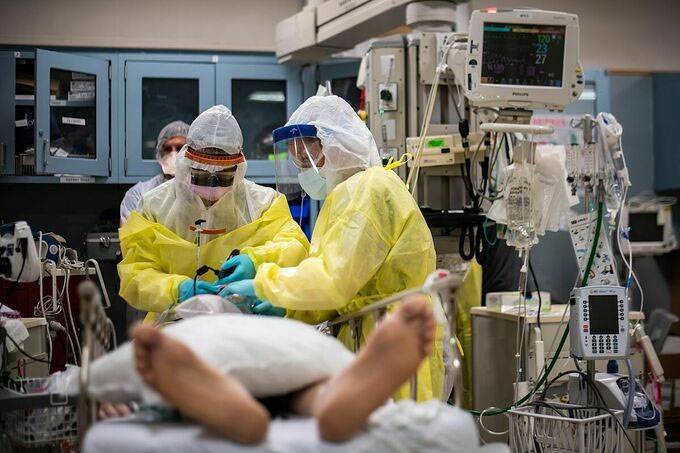A strange phenomenon caused the sudden death of Covid-19 patient
Many people with nCoV still talk and walk normally, but the blood oxygen level is so low that it can cause unconsciousness or death at any time.
Experts call this the "silent hypoxia" phenomenon , which occurs when the person is unaware of their lack of oxygen. Most people are hospitalized with health much worse than they imagined.
Typically, these patients exhibit Covid-19 symptoms for two to 7 days before coming to the hospital. They "feel chest tightness or cannot breathe deeply," said Dr. Richard Levitan, Littleton Health Center, New York City.
He spent nearly two weeks volunteering in the emergency room at the epidemic center. There, he monitored patients hospitalized with 50% blood oxygen levels, so low that they could cause unconsciousness, speaking poorly. The results of a pulmonary scan showed a serious sign of inflammation, which should have been painful, causing the patient to gasp.
"X-rays looked terrible. But they were fully awake, able to use cell phones. They were all sick for days. But only recently have they felt short of breath, tired and having problems." other problems, " says Dr. Levitan.

Doctors at Maimonides Medical Center, USA, conducted intubation for Covid-19 patients. (Photo: WSJ).
This is a dangerous phenomenon because when people infected with nCoV notice abnormal signs of breathing, the disease is already in a very serious stage.
"Some even use ventilators. The concentration of carbon dioxide increases, the fluid accumulates in their air pockets, their lungs harden, leading to acute respiratory failure," he added.
Doctors surmise that for some people, the symptoms of Covid-19 do not progress quickly. Dr. Cedric Rutland, American Lung Association, explained that when oxygen levels drop significantly, the body will automatically compensate by increasing breathing and patients get used to the speed. Many people are not aware of this and do not seek the help of a doctor.
By the time they were hospitalized, serious injuries had occurred, not only with the lungs but also with many other organs such as the heart, kidneys and brain. The situation of "silent hypoxia" may explain some cases of young patients without background disease, nCoV infection and sudden death.
In the early stages of the pandemic, almost all patients were given ventilators after hospitalization. Currently, your physician is trying to find an alternative such as an oxygen mask or to adjust your lying position. Experts say this benefits both health care workers and patients.
To connect a ventilator, the doctor must put an intubation. The process is not pleasant. Many people have to use sedatives to keep the catheter from falling asleep. Mechanical ventilation can also lead to infections, pneumonia or blood clots.
To avoid the "silent hypoxia" phenomenon , Dr. Richard Levitan called for an early diagnosis by giving mild symptomatic Covid-19 patients using a blood oxygen meter during two weeks of isolation. He also suggested that people measure the index at home by hand-held devices, quickly go to the hospital if there are signs of abnormality.
However, the problem is the accuracy of the personal gauges marketed. A 2016 study found that only 30% of the devices tested met the International Standards Organization's criteria.
- What are the characteristics of a person dying from Covid-19 infection?
- CDC USA adds 6 new symptoms to Covid-19 patients
- Covid-19 patients may have impaired pulmonary function after recovery
- Why did Covid-19 patients recover from the positive test?
- Covid-19 patients may have impaired pulmonary function after recovery
- Decode the cause of a sudden death in Siberia
- Beware of sudden death in young people
- Identify 'hidden culprit' causing sudden death in young people
- Discovered the culprit causing the sudden death of young people
- What is community immunity? Does it apply to Covid-19?
- Babies who suck on rubber breasts when sleeping reduce the risk of sudden death
- Tests know the risk of sudden death 10 years later
- Prevention of sudden death in elderly people during the hot season
- Warning of abnormal deaths in babies
- Strange disease: A patient with lymphadenitis caused by cat bugs
- The frightening phenomenon caused thousands of sudden death in America
 Chinese doctors have created medical masks that cover only the nose for convenience of eating and drinking
Chinese doctors have created medical masks that cover only the nose for convenience of eating and drinking Scientists have found a way to help you regrow new teeth after only 2 months
Scientists have found a way to help you regrow new teeth after only 2 months Do non-stick pans cause cancer? What alternatives are there?
Do non-stick pans cause cancer? What alternatives are there? Blisters around the body: Causes, symptoms and treatment
Blisters around the body: Causes, symptoms and treatment